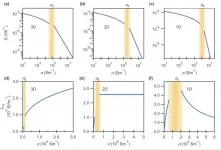(Press-News.org) Workplace communication often took a back seat this past year, as employees and employers rushed to work remotely, struggled with technology barriers and adjusted to physical distancing. But the pandemic has resulted in valuable lessons for communicating on the job, according to a Baylor University study.
During the onset of COVID-19 -- along with accompanying layoffs and a recession -- "there likely has never been a moment with such demand for ethical listening to employees," said lead author Marlene S. Neill, Ph.D., associate professor of journalism, public relations and new media at Baylor.
"Ethical listening" was defined by one communication manager as "listening with an open mind and being able to hear the good, the bad and the ugly. Strategic listening is then taking the good and the bad and the ugly and knowing how to use the information."
For the study, published in the Journal of Communication Management, researchers interviewed 30 communication professionals in the District of Columbia and 13 states: Arkansas, California, Delaware, Massachusetts, New Hampshire, New York, North Dakota, Ohio, Oklahoma, Pennsylvania, Texas, Virginia and Washington. Interviewees represented technology, financial and legal services, food and beverage, hospitality, energy, health care, trade associations, transportation, higher education and consultants.
The professionals interviewed stressed the importance of protecting confidentiality so employees feel comfortable giving feedback and do not fear retribution.
When COVID-19 hit and workers often no longer shared physical quarters, the use of Zoom soared, whether for large group meetings or one-on-one sessions, researchers noted. And while senior managers valued communication, it became less of a priority as companies made such quick changes as mandated quarantines.
For communications professionals, remote work made it harder for them to build trusting new relationships. They, like others, felt isolated, missing critical conversations and small talk.
"We heard that the pandemic posed challenges in internal communication due to the alienation many employees experienced, and it prompted us to reevaluate the moral responsibility communications holds for keeping employees feeling connected to their teams," said co-researcher Shannon A. Bowen, Ph.D., professor of journalism and mass communications at the University of South Carolina.
The study shed light on companies' challenges, how they strove to meet them and how they might use those strategies in the future.
For example, a communication manager for a trade association of the hospitality industry said that its members also are primary stakeholders in their companies.
"There were stakeholders who were saying, 'I'm going to have to close my doors. Please do something.' And there's only so much we can do. It called for a different type of empathetic listening. This is these people's livelihood. In hospitality, that's like any business owner, that's their baby. But it's not just their baby. It's a baby that generates income for the employees they deeply care about. It's not just that it impacts them; it impacts their employees, which is a double cut to the heart."
Meanwhile, a communication manager in health care encouraged senior leaders to schedule 30-minute "walk-around" sessions -- whether masked and in person or via technology.
"Trust has to be built with actions and follow-through, not just words," Bowen said.
For all the organizations studied, "the desire and follow-through to ethically listen to employees appeared to be a challenge," Neill said.
Most participants said the ratio of management messaging to employees compared to feedback was lopsided, with far more talking than listening.
"We cannot promise we are going to fix everything," said a communication manager in the financial services industry. "But we have the mantra if you are asking for feedback, it is critical that you close the loop and say that."
Communications managers often have limited staff to analyze feedback. They also contend with a lack of communication between departments, especially in larger organizations.
To solve those problems, some communications professionals suggested having a team member to sit in on department meetings and serve as a liaison. One professional in a law firm said she makes it a point to invite the less vocal members to share their thoughts, while another uses on-on-one meetings for them.
"They open up a lot more when it's just one on one," she said. "In groups, large groups, they do not speak as freely, because there's a hierarchy. If the older, more senior people are not saying anything, then the younger less seasoned attorneys more than likely will not say anything."
Some internal communicators also said that during the pandemic, they saw a need for shorter, more focused meetings, in part to cut down on stress. And one consultant said that more visual communications, such as videos and video conferencing, seemed to help employees feel that they are cared for.
"I'm making sure that I have my eyes trained on the screen on the facial expressions," said a communication manager for a trade association. "Part of active listening is also looking for visual cues of the reactions of your colleagues."
Neill said the researchers were encouraged by the heightened level of empathy for the impact of organizational decisions on employees' lives.
"We recommend that senior leadership and communication professionals seek ways to continue to improve moral sensitivity well after the global pandemic has receded, which can lead to more ethical decision-making," she said.
INFORMATION:
*The study was supported by a Page Legacy Scholar Grant from The Arthur W. Page Center at The Pennsylvania State University's College of Communications.
April12, 2021 - Gray wolves are among the largest predators to have survived the extinction at the end of the last ice age around11,700 years ago. Today, they can be found roaming Yukon's boreal forest and tundra, with caribou and moose as their main sources of food.
A new study led by the Canadian Museum of Nature shows that wolves may have survived by adapting their diet over thousands of years---from a primary reliance on horses during the Pleistocene, to caribou and moose today. The results are published in the journal Palaeogeography, Palaeoclimatology, Palaeoecology.
The research team, led by museum palaeontologist Dr. Danielle Fraser and student Zoe Landry, analysed evidence preserved in ...
HOUSTON -- Early phase clinical trials conducted by researchers from The University of Texas MD Anderson Cancer Center show promising results for patients with RET fusion-positive cancers, high-grade (HGG) and low-grade glioma (LGG) and ovarian cancer.
The results, presented today at the virtual American Association for Cancer Research (AACR) Annual Meeting 2021, showcase the researchers' ongoing efforts to advance clinical studies and expand potential indications of approved drugs to develop a platform for more effective treatments and to improve patient outcomes.
FDA-approved selpercatinib shows clinical benefits for RET fusion-positive ...
PHILADELPHIA--Giving early-stage pancreatic cancer patients a CD40 immune-stimulating drug helped jumpstart a T cell attack to the notoriously stubborn tumor microenvironment before surgery and other treatments, according to a new study from researchers in the Abramson Cancer Center (ACC) at the University of Pennsylvania. Changing the microenvironment from so-called T cell "poor" to T cell "rich" with a CD40 agonist earlier could help slow eventual progression of the disease and prevent cancer from spreading in more patients.
The data--which included 16 ...
LOS ANGELES -- Early results from a new, pioneering chimeric antigen receptor (CAR) T cell immunotherapy trial led by researchers at the UCLA Jonsson Comprehensive Cancer Center found using a bilateral attack instead of the conventional single-target approach helps minimizes treatment resistance, resulting in long-lasting remission for people with non-Hodgkin's B-cell lymphoma that has come back or has not responded to treatment.
The new approach, which will be presented at the American Association for Cancer Research Annual Meeting during one of the clinical oral plenary sessions ( END ...
New York, NY (April 10, 2021) - A personalized cancer vaccine developed with the help of a Mount Sinai computational platform raised no safety concerns and showed potential benefit in patients with different cancers, including lung and bladder, that have a high risk of recurrence, according to results from an investigator-initiated phase I clinical trial presented during the virtual American Association for Cancer Research (AACR) Annual Meeting 2021, held April 10-15.
"While immunotherapy has revolutionized the treatment of cancer, the vast majority of patients do not experience a significant clinical response with such treatments," said study author Thomas Marron, MD, PhD, Assistant Director for Early Phase and Immunotherapy Trials ...
HOUSTON - Researchers at The University of Texas MD Anderson Cancer Center have discovered that mutant KRAS and p53, the most frequently mutated genes in pancreatic cancer, interact through the CREB1 protein to promote metastasis and tumor growth. Blocking CREB1 in preclinical models reversed these effects and reduced metastases, suggesting an important new therapeutic target for the deadly cancer.
The findings were published today in Cancer Discovery and presented at the virtual American Association for Cancer Research (AACR) Annual Meeting 2021 by Michael Kim, M.D., ...
Research from Queen Mary University of London has revealed novel insights into the effects of chemotherapy on the tumour microenvironment (TME). The study, published today in Cancer Immunology Research, a journal of the American Association for Cancer Research, found that chemotherapy enhances the anti-tumour actions of immune cells within the TME and their ability to support immune responses against cancer.
Cancers are not just a mass of cancerous cells, but are rogue organs made up of many different cell types, including cells that form connective tissue and blood vessels, and immune cells. These non-cancerous cells have been recruited and corrupted by the cancer to help it grow and spread, and constitute what ...
Patients with non-small cell lung cancer (NSCLC) whose cancer cells have low levels of aneuploidy - an abnormal number of chromosomes - tend to respond better to immune checkpoint inhibitor drugs than patients with higher levels, Dana-Farber Cancer Institute researchers will report at the virtual AACR Annual Meeting 2021.
In analyzing data from hundreds of patients with NSCLC who were treated with these drugs, the researchers found that those whose cancer receded tended to have less aneuploidy in their tumor cells than those whose disease remained stable or worsened. These findings suggest that aneuploidy testing can have an important role in determining which ...
Tokyo, Japan - Researchers from Tokyo Metropolitan University have shown that a quantity known as "thermoelectric conductivity" is an effective measure for the dimensionality of newly developed thermoelectric nanomaterials. Studying films of semiconducting single-walled carbon nanotubes and atomically thin sheets of molybdenum sulfide and graphene, they found clear distinctions in how this number varies with conductivity, in agreement with theoretical predictions in 1D and 2D materials. Such a metric promises better design strategies for thermoelectric materials.
Thermoelectric devices take differences in temperature between different materials and generate electrical energy. The simplest example is two strips of ...
From power grids and telecommunications to water supply and financial systems, digital data controls the infrastructure systems on which society relies. These complex, multi-tier systems depend on layered communications to accomplish their tasks - yet every point of contact becomes a potential target, every path of information a potential weak spot for malicious actors to attack.
A team of researchers from the University of Calabria in Italy has developed the first predictive control scheme that can help distributed networks with multiple agents not only identify these ...




